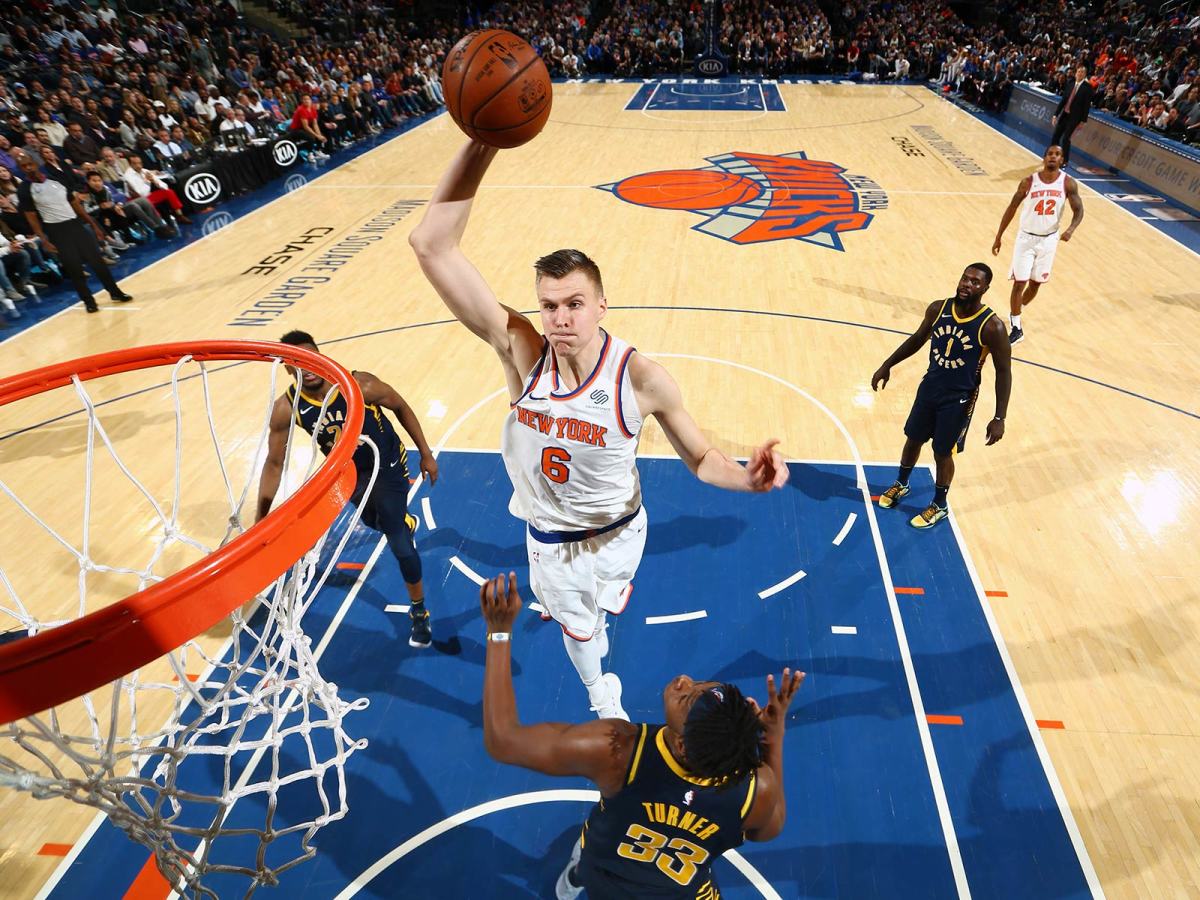The NBA's Best Unicorn: Kristaps Porzingis

This story appears in the November, 20-27, issue of SPORTS ILLUSTRATED. To subscribe, click here.
One could make out the silhouette of a superstar in New York City last season, although it was often obscured by Phil Jackson's hazy nostalgia, Carmelo Anthony's long shadow and owner James Dolan's general messiness. After all, Kristaps Porzingis's talent is impossible to contain.
Following a fourth straight lottery trip, the Knicks unfurled an uncharacteristically logical offseason plan: Ditch Jackson, trade Anthony, part ways with Derrick Rose and let Porzingis run wild. That thorough housecleaning has left the 7'3" Latvian big man as the focus of New York's attack—and enabled him to fulfill his prodigious potential much more quickly than anyone could have imagined. Through the end of the week, Porzingis boasted the statistical portfolio of an MVP candidate, ranking second in scoring, second in usage rate, third in blocks and second in Player Efficiency Rating. If he maintains his current scoring clip (30.4 points per game), he will join Hall of Famers Wilt Chamberlain and Kareem Abdul-Jabbar as the highest-scoring 7-footers in league history. At age 22.
Observers have long cast Porzingis as a "unicorn," but even that mythical label doesn't encapsulate the rarity of Porzingis's game—at both ends of the floor—now that it has been more fully realized. As New York's lead scoring option, he has hammered home thunderous alley-oops, glided through the paint for impossible-to-block runners, backed down smaller defenders to set up turn-around jumpers and buried deep threes from Stephen Curry territory.
Unleashed Porzingis recalls both Abdul-Jabbar and Kevin Durant. His length poses an unsolvable problem for defenders, whether he is swooping to the hole with the ball high above his head or squaring up for a quick-release jumper that no wing can adequately contest. His smooth shooting stroke and soft touch only add to the unfairness.
Perhaps the best method for appreciating Porzingis's deep offensive toolbox is to brainstorm the ideal defender to oppose him. The Porzingis stopper would need Rudy Gobert's height and wingspan to challenge his dunks and Draymond Green's motor to wear him down. He would need Kawhi Leonard's hands and instincts to make him work to get to his spots, plus Durant's long arms and versatility to really limit his perimeter effectiveness. In other words, all it takes to neutralize Porzingis is a Frankenstein's monster made up of the four Defensive Player of the Year candidates.

In a fascinating wrinkle Porzingis's breakout is occurring as the NBA plunges deeper into its Pace and Space era. The 2017–18 season has approached a 25-year high in terms of pace, and teams are once again launching a record number of three-pointers. During the 2017 Finals, the Cavaliers and the Warriors occasionally fielded interchangeable lineups that featured five players all listed at 6'9" or shorter. Yet Porzingis, who shares the NBA's tallest player honors with Detroit's Boban Marjanovic, hasn't been left behind by all the running and gunning, and he hasn't drowned in the small ball wave.
Unlike many centers who struggle to play perimeter defense against smaller opponents, Porzingis is usually agile enough to get by, even against lineups that feature five outside shooting threats. His 7'6" wingspan helps him close out on shooters, and it allows him to recover to block shots from behind when he gets beat off the dribble. During the 2015 predraft process, an anonymous front-office executive famously told NBA.com that Porzingis was "light in the pants." One advantage of the small ball trend: The lanky Porzingis's limited physicality around the basket is less of a problem than it would have been a decade ago.
Offensively, Porzingis isn't a drag or a hindrance in the slightest. New York plays at a slightly below-average pace, but Porzingis is a transition threat. When ahead of the play, he's a lob target capable of contorting his body in midair for spectacular finishes. As a trailer, Porzingis can cut through the paint or step into a walk-up three with equal ease. From a spacing standpoint, Porzingis profiles as an elite modern wing: He's shooting 42% on five three-point attempts per game, a level of volume and efficiency on par with Leonard and Durant last season.
Opponents are left grappling with the conclusion that Porzingis is bound to win the mismatch game far more often than he loses it. Their natural reaction will be to send extra defensive help, and Porzingis will need to prove that he can consistently read double teams and make the right passes to his teammates.
To the Knicks, Porzingis isn't just a souped-up unicorn or a likely first-time All-Star. The early favorite for Most Improved Player is an ideal building block whose presence provides an identity and reduces the pressure on role players. Title contention remains many moves and multiple years away, but Porzingis's fast start has reintroduced a pair of long-lost sentiments in New York: genuine excitement and long-term optimism.
